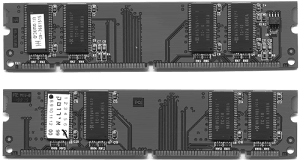Physical RAM Capacity
Several types of memory chips have been used in PC system motherboards. Most of these chips are single-bit-wide chips and are available in several capacities. Note that chip capacity typically goes up by factors of four because the dies that make up the chips are square.
When they increase capacity, this results in four times more transistors and four times more capacity. Most modern SIMMs and DIMMs use 16Mb–256Mb chips onboard. Many memory manufacturers use similar schemes for numbering their chips; however, if you are really trying to identify a particular chip, you should consult the manufacturer catalog for more information.
Because this chip is 8 bits wide, I'd expect to see either 8 or 16 of them on a DIMM to make up the 64 bits of width for the complete DIMM. If 16 chips were used, this would be known as a double-sided DIMM and the chips would be arranged in a logically stacked form in which the two banks of 8MBx8 chips work together as if they were a single bank of 16MBx8 chips.
If 8 of these chips were on a DIMM, it would be 8MBx64 bits, which is the same as saying 8MBx8 bytes, which is the same as calling it a 64MB DIMM. If there were 16 of these chips, it would be a 128MB double-sided DIMM, and if there were either 9 or 18 of these chips, it would be a 72-bit wide DIMM with parity/ECC support.
Most chips also feature a four-digit number separate from the part number that indicates the date of manufacture by week and day. For example, 0021 indicates the chip was made in the 21st week of 2000. To further decode the chip, contact the manufacturer or chip vendor for its catalog information.
SIMMs and DIMMs also have part numbers that can be difficult to decode. Unfortunately, no industry standard exists for numbering these modules, so you must contact the manufacturer if you want to decode the numbers.
Sometimes you can't find any writing on the module that tells you the capacity or other information. In that case, just look up the chip part numbers on the chip manufacturer's Web site, and from there you should be able to figure out what it is (see figure below).

The fact that I can't decipher the information on the stickers about the DIMM is not a problem, as long as I can read the chip part numbers. The chips carry the Hyundai (HY) logo, with a part number of HY57V651620-TC10. I found the data sheet for these chips at the Hyundai Memory Web site.
I can't tell who made the actual DIMM; at first I suspected Hyundai might have made it because of the HY-3U1606 number on the left side, but I can't find any corresponding information in the Hyundai catalog that matches this designation. No matter; I can still deduce all the information I need about this module by looking at the chip information.
According to the data sheet for the chips on this DIMM, these are 10ns chips, which, although technically rated 100MHz, would classify this as a 66MHz SDRAM DIMM (PC66). If they were 8ns (125MHz) chips, this would be a PC100 DIMM, and if they were 7.5ns, this would be a PC133 DIMM.
These are 64Mb chips, organized as 4MBx16 (rows by columns). Four chips are on one side, resulting in a full 64-bit wide bank of 4MBx64 bits (4MBx8 bytes or 32MB total). The other side contains the same number of chips, which would be electronically or logically "stacked" to double the depth (number of rows).
This is because DIMMs can be only 64 bits wide, resulting in a total of 8MBx64 bits, which is 8MBx8 bytes, which is 64MB total. The additional tiny Atmel brand chip on the right side is the serial EEPROM, which contains the data about this DIMM that can be read by the motherboard to configure the chipset memory controllers.
Because there are no additional memory chips, this DIMM lacks the additional 8 bits of width to make it a 72-bit wide ECC DIMM. So, by deciphering the chip part numbers and adding things up, I have figured out that this is a 64MB, double-sided, non-ECC, PC66 SDRAM DIMM.